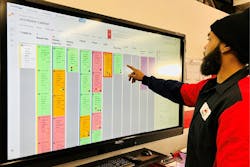The Reviewer:
Rob Stringer got involved in the industry 18 years ago. Six years ago, Stringer purchased Arizona Collision Center with a few financial backers, and a little over a year ago, he bought them out and now owns the facility with his wife, Tracy.
The Shop:
The 10,000-square-foot shop is located in Tempe, Ariz., and employs 13 people. The family-owned business is 100 percent independent from DRPs.
Communication between production and non-production staff is an issue that many shops, including Stringer’s, struggle with. Stringer knew that one way to improve this is by having a clear point for everyone in the shop to reference, such as a workflow board.
“It was a necessary stepping stone to get the entire shop behind the process of the digital board,” Stringer says.
Since Stringer worked with the team at AkzoNobel on an early version of the system and had expressed so much interest, AkzoNobel made sure that Arizona Collision Center was the first shop on the West Coast to have access to Carbeat—its digital workflow management tool. The shop has used Carbeat for a little over six months.
How it Works:
Once a vehicle enters the shop, information is input into Carbeat by Stringer’s office manager and a digital ticket for that job is created. Every time the vehicle is physically moved in the shop, the job can be moved on the digital touch screen by a user dragging and dropping it.
Since Carbeat is cloud based, the updates occur in real time. So, as soon as one person in the shop makes a change to a job, everyone can see it immediately. The columns and colors indicate the status of various jobs, which are determined on an individual basis. Stringer says that a quick glance at the board can answer questions about sublets, delivery date, or any other questions someone in the shop might have about a particular vehicle.
By collecting all of this information, Carbeat can also be used to create reports that can help identify areas in the shop that are weak and should be improved. For example, Stringer has used it to analyze waste in his shop and identify the areas in the shop that vehicles have been idle. He’s also been able to use reports with insurers to point out the insurers that have taken longer to approve repairs than others.
The Review:
Carbeat has created a synergy at Arizona Collision Center, says Stringer. Stringer uses the 70-inch screen as reference during his morning and afternoon meetings to show everyone what’s going on in the shop and any areas that might need addressing. It helps prevent things from falling through the cracks.
“One thing we always forget about is sublet operations or various things like an alignment,” Stringer says. “With this tool, it tracks every operation and, at the end of the day, you know that you’ve addressed every operation since it’s been marked since it came in.”
The workflow is not only displayed on the 70-inch touchscreen, but the staff members can also access it through their own personal laptops. Stringer likes this because it means the staff doesn’t have to waste time walking from one end of the shop to the other to make an update or check something on a vehicle.
Stringer still uses a shop management system to communicate with his customers, but he says that Carbeat shows more information about the state of each repair and is easier to reference than scheduling tools he’s seen in other systems. He also adds that access to the proprietary data and the reporting tool have set it apart from any other system he’s used.
The ROI:
Since Stringer started using AkzoNobel’s scheduling tool 2.5 years ago, he says that his net profit jumped 4.3 percent within six months and has steadily stayed there.
Stringer says that the $350 per month is easily recouped and that it’s made his shop more efficient and helped point out problem areas in a shop.



